 by Valerie Jurik
by Suzanne Felber
Frank Rolfe
by Kurt Kelley
by Paul Bradley
by Austin Lewis
by Spencer Roane
by John Graham
by Kurt Kelley and D.J. Pendleton
by James Bartholomew
by Dave Reynolds
by Valerie Jurik
by Suzanne Felber
Frank Rolfe
by Kurt Kelley
by Paul Bradley
by Austin Lewis
by Spencer Roane
by John Graham
by Kurt Kelley and D.J. Pendleton
by James Bartholomew
by Dave Reynolds
From the Publisher
Design Is Your Key
12 Things You May Not Know About Selling MHs in Your MHP/LLC
Why Prospecting Fails And What To Do About It Engaging Prospects So They Want To Find You
How To Succeed With Small Manufactured Home Communities by
Letter to the Editor from David Roden Justice Antonin Scalia: A Verdict By A Couple Manufactured Home Industry Lawyers
Ten Tips for Better Welfare States
Why We Love Investing In College Towns
Attending Vegas Trade Show is a Good Investment
Turning your Retail Center Into a Profit Center
Investing in Troubling Times
From the Publisher
Kurt D. Kelley, J.D.

You can say many things about the manufactured home industry, but you can’t say we’re pretentious or cold. Walking through Dennis Hill’s well organized and well run “Tunica Home Show”, there’s no end to the warm welcomes and friendly faces.
Everyone from the home installation crews and manufacturers’ representatives, to the vendors’ representatives were happy and smiling. Upon my arrival, MHProNews’ Tony Kovach even gave me a high five from a moving suburban as I made my way into the building. This good vibe even ran through to the Hollywood Casino staff. They were consistently welcoming and warm which is a good reminder to any business operator that customer greetings and welcomes matter. My guess is that the “Brain Surgeons” and “Rocket Scientists” industry events aren’t nearly as friendly as ours.
Congratulations to Cavco Industries and Lexington Homes for joining forces. From what I know about the geographic territories each covers and corporate cultures of their respective companies, this looks like a good marriage. Their leaders, Joe Stegmayer and Gene Rogers, have reputations for being hard working, smart managers.
Though I doubt they need it, I wish both men and their companies good luck as they move forward.
Thank you for your support and readership.
Please consider this your invitation to advertise with us as well as submit an article for review.
Sincerely,
Kurt Kelley
Page 3
Being a Certified Aging In Place Specialist gives people an instant association that I work with old people Whenever the word aging appears we all go to the first thought that pops up in our head such as: wheelchairs, grandparents, my parents, grey, bald or thinning hair. Why is that?
After years of studying why people do what they do, you have to give credit to how we are raised, what we are taught, and what we see for ourselves. But what if we start to look at aging as something we do from the minute we are born to the last breath we take, and not see it as a word that describes older, lesser than and those people?
I’ve been working in healthcare and the housing industry for over 30 years. My entire career has been focused on helping people to live at home for as long as possible regardless of age and ability Today they call it Aging In Place (AIP) though I feel that Thriving In Place is a much better alternative. No one cares to age but we all want to thrive. Either way, I feel they finally named my wheelhouse.
To me AIP has 3 components:
1. Universal/Inclusive Home Design

2. Products/Technology
3. In Home Services
If keeping people at home for as long as possible is the driving point, then their home is KING and where it all starts.
There is a disconnect between the perception of “aging in place” by adding grab bars and installing wheelchair ramps versus the reality Many design features can enhance the livability of a home for all ages and there you have the first great point.

DESIGN IS YOUR KEY
I recently wrote an article titled Whine or Design that draws the line in the sand I tell people that they can complain about the inability to freely move about in their present house, or worry about buying a new house that may not function well as they age. So they can whine.
Or you can start to understand that inclusive design can make your home a Forever Home™ Here is where I educate people as to what design can truly offer so they can take that education to the home builder or the remodeler.
I also educate the builders so they can hand a sense of comfort to their potential customers if they don’t already know about what design can create.
Page 4
(The following is from Marianne Cusato’s 2016 AIP report)
Making someone’s home more livable is something everyone wants to do regardless of their age A young person, for example, can get excited about a kitchen that includes a pot filler over the stove and base drawers instead of lower cabinets, both of which make the kitchen more functional when preparing meals for the family Likewise, a young urbanite who’s redoing their bathroom can feel enthused about putting bench seating in the new steam shower so they can take a relaxing steam after a long day on their feet at work It just so happens that the same features that help these younger homeowners thrive in their homes will help their older future selves do the same It’s all about maximizing comfort, convenience and, as a result, happiness.
Improvements that make homes livable only for some (e g , raised toilet seats, chair lifts, walk-in tubs) risk making them appealing to none. Improvements that make homes universally more livable (e.g., replacing lower cabinets with pull out drawers, large windows providing natural light), however, will make them appealing to everyone as we age”
I was a speaker for two events at the International Builders Show in Orlando this past January. I gave a presentation about “Aging in Place”, showing that showed the aging of America, the desire of people, what it’s creating in housing, and what to do about it. The biggest aha moment I saw in most people was when I spoke about AIP being for all generations and not just the aging population So many professionals today talk about “Boomerang Children”* issues and our aging population What to do and what not to do I talk about all ages and what can be done so every age can benefit from the same thing by giving choices.
I feel the more you educate the more you empower people with choices Your business will be seen as the generator in your field. When the going gets tough and it’s lights out for some, all you have to do is flip the switch.
*Children who move out of their family’s house, purportedly to get jobs and/or start their own lives, but who return shortly thereafter to live with their parents again. – UrbanDictionary.com
Valerie Jurik is a Certified Aging in Place Specialist (CAPS), a professional speaker, author and advisor/consultant. With over 30 years of experience in healthcare and housing, she has a unique view when it comes to educating businesses, industries and families. Valerie became a speaker and advisor to help businesses and communities see that important decisions are made better as educated choices rather than a gamble. With Valerie’s years of experience, she navigates the waters to help you better understand aging, Aging In Place, and how to engage in the market. 919-599-6940

www.valeriejurik.com
info@valeriejurik.com
Page 5
Cheers!
~Valerie
12 Things You May Not Know About Selling MHs in Your
1. Street Retailers – Broad changes in mortgage financing, to curb fraud & predatory lending over the past 10 years, significantly reduced the number of street retailers, meaning community owners (COs) could no longer rely on street retailers to fill rental home sites.
2. Seller Financing – The S.A.F.E. & Dodd-Frank Acts of ’08 prohibit seller-financing of homes on-site as per past practice(s).
3. Repossessed Manufactured Homes (‘REPO MHs’) – Plentiful when production and chattel financing of MHs were going gangbusters, along with repos/defaults. Nowadays, they’re hard to find, expensive, and already old.
4. New Manufactured Homes – Community Series Homes (CSH) debuted in 2009. They are new, lower-priced, functional, energy efficient MHs specifically designed for residents of land lease communities (LLCs).
5. MH Manufacturers – want your business! 30-40% of all new MHs being produced today are going into communities, with this number increasing annually.
6. Renting MHs – Some COs do exceptionally well with programs that rent new MHs like upscale apartments.
7. Lease-Option “sale” of MHs – A satisfactory means of conveying MH title in communities in many states. Contact Joe Kelly, executive director of the IMHA, joe@iamha.org 515-265-1497 for a complete set of L-O paperwork. Other L-O information is posted at www.LeaseOptionMHSales.com
8. Financing – More financing is available today than ever, for COs to acquire MHs to rent or sell, via L-O: American Commerce Bank (Atlanta), Cavco Revive, 21st Mortgage, private investors, and Legacy Homes, to name a few.
9. Selling New MHs – they’re easier and quicker to sell than repos, upgrade communities, and attract better clientele.
10. Multi-section vs. Single-section MHs – emerging data suggests multi-section (“doublewide”) MHs are more attractive to buyers, sell faster, and have fewer buyer complaints, and fewer seller-finance (L-O) defaults
11. Ability-to-Repay (ATR) – considered by many the single-most important criteria when qualifying home buyers. Maximum 30% and 40% front-end and back-end DTI ratios, respectively, along with thorough reviews of credit history, employment history, rental history, and criminal history, ensure buyers are faithful to the transaction over the long term.
12. Defaults – average annual default rates of 2-3% of existing L-O contracts in portfolios held by small community owner/operators are realistic with new homes and properly qualified “buyers”.
Small owners/operators control many more LLC lots in the U.S. than larger operators. Consider attending the Southeast Community Owners’ (SECO) Symposium in Atlanta in October to network with over 300 other small and mid-size operators, tour CSH homes on display, two days of presentations and panel discussions, pre-SECO workshops, and 50 vendors from throughout the MH industry.
Page 6
Contact genevieve@secoconference.com 770-871-6889.
MHP/LLC
spencer@roane.com
(678) 428-0212
Pentagon Properties, Inc.
Linkedin profile.
Spencer Roane, president of Pentagon Properties, Inc., Atlanta, Ga., owns and manages four land lease communities in Georgia and Texas. His firm has sold over 300 new & previously-owned manufactured homes in his communities over the past 25 years via Lease-Option contracts. Over the past 6+ years they sold and seller-financed over 50 new manufactured homes with only 3 defaults. Since passage of the S.A.F.E. & Dodd-Frank Acts he was written about and spoken often to advocate use of LeaseOption contracts to sell new and pre-owned manufactured homes in communities in most states.
He is a member of the Georgia Manufactured Housing Association where he served as an officer and member of the board of directors. He served on the National Communities Council (NCC) and the Disaster Housing Task Force of the Manufactured Housing Institute (MHI). He is one of the organizers of the Southeast Community Owners (SECO) conference which attracts 150-200 small and mid-size community owners annually.

Spencer holds a B.S. degree in Electrical Engineering, a M.S. degree in Industrial Management, and both Mortgage Loan Originator and Mortgage Broker S.A.F.E. Act licenses

Page 7
from David Roden, Mountain View Estates
We seem to have two groups; the owners that care about people and want to make a profit, and the owners that do not care about people and want to make a profit.
For myself, I'm of the group who believes we educate the public and introduce them to our product first hand. I've had brand new Palm Harbor homes and taken our Mayor, City Clerk and a Newspaper Writer for a tour all at the same time. I point out the crown molding, ceramic tile floors, R-30 plus insulation, 2' x 6' exterior walls, heat pumps, etc. They were amazed. When was the last time an elected official toured your community or you took a media representative into your new homes? We had the County Commissioner, the county Fire Marshal and Sheriff in our new Tornado Shelter as well as local news media. Our tornado shelter got picked up on the AP news wire the other day after the storm hit a park in Southern Alabama a few weeks ago. I have other park owner friends who give scholarships to the kids in the park for academic achievement. I'd like to be in the group who cares for the residents and also wants to make a profit.
Then we have slumlords. They rent to anyone with warm blood. There are no criminal background checks for pedophiles or felons. There's windows that have been replaced with cardboard, doors that do not lock, no fire extinguishers, holes in floors, exposed electrical panels, no heat in the winter, steps that are rotten, and roofs that are rusted and leaking. Charging by the week, they become millionaires off those who can least afford to pay the weekly payments.
I agree with Frank Rolfe that each of us can and should contribute something positive to the news media every chance we get. We do need to change the perception of our industry rather than waiting or expecting the lobbyists of our industry to do it for us.
With that said, it's the slumlords in our industry who continue to give us a bad name. I have a neighboring park that has thrown out old furniture, mattresses, and garbage on the ground for the past 20 years. The stink coming from the mattresses alone will make you sick. Bedbugs, fleas and lice are covering the kids in these parks. What are we going to do to address these problems within our groups? Will we ignore this, allowing them to continue to financially rape these folks, knowing these tenants can't do any better?
If this perception is reality, is our industry standard destined to be dictated by these slumlords who call themselves Manufactured Home Community Owners? Is this really what our county wants to be known for - a county of those who want to fly under the radar.
As for myself, I'm going to continue to talk to my elected leaders, asking them to work with us and explore ways to end these abuses. For example, if a law enforcement agency has to visit one of these communities ten times a week, is this not considered a public nuisance? Is the owner contacted and the community shut down if it continues?
We should generate our own PR and do better. It does not look like our industry leaders are going to birth a National Public Relations Campaign anytime soon. I'll pledge to you right now my $100 a month from my business of 70 residents, for the next year to start a national media campaign about the quality affordable housing our industry provides to those who want and deserve an affordable lifestyle in a decent place to live.
Page 8
Letter to the Editor
MVE, Inc. is a manufactured housing community called Mountain View Estates located in Rossville, Ga. David co- founded a Chattanooga area nonprofit group called EREC, which was formed to bridge a gap between schools and the business community. He spent a year with a group of volunteers to build a 15,000 sq. ft. playground in one week in East Ridge Tennessee when thousands of members of the community brought their tools and built the playground for the area. His proudest accomplishments are his family Judy, Katie and Andrew and working at Mountain View Estates with his Dad for the past 20 years.

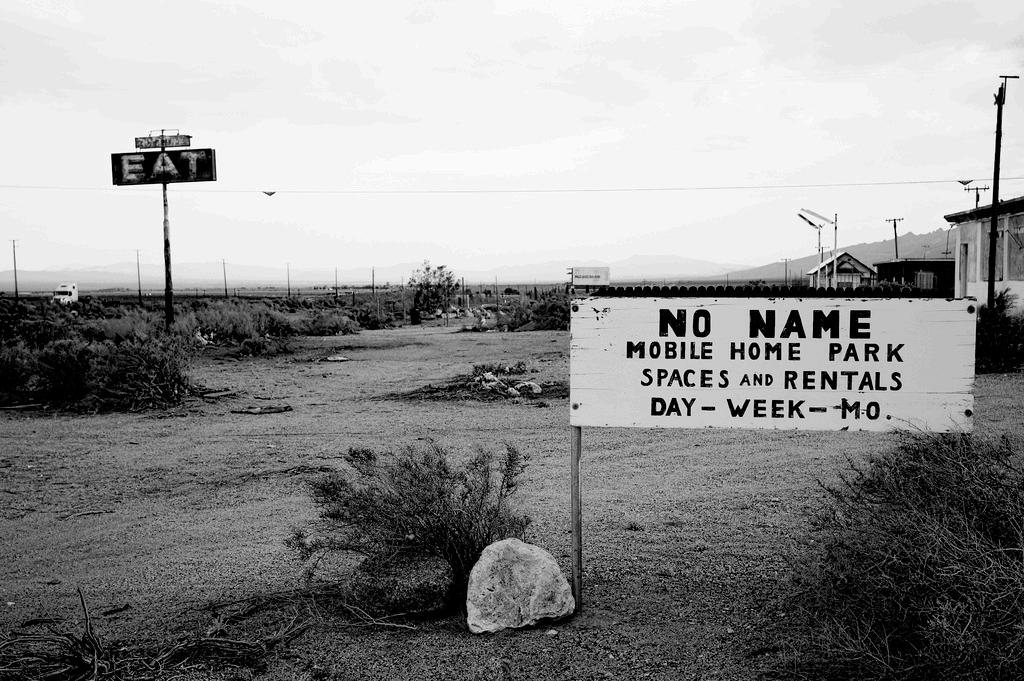
 David Roden is President and CEO of MVE, Inc.
David Roden is President and CEO of MVE, Inc.
Dog Bite Liability Solution for Your Community Owners

A New Breed of Insurance: Coverage for Medical Expenses and Legal Defense if FIDO Causes An Injury
Every year in the United States more than 4.7 million people are bitten by dogs. – Center for Disease Control and Prevention

Do you have a good tenant with a dog that doesn’t fit your community guidelines?
Mobile Insurance has partnered with an insurance provider to offer a possible solution!
Direct your tenant to www.dogbitequote.com Advise them your minimum is $300,000 of liability insurance and they must add you as an “Additional Insured” on their policy. Once their policy is issued let them know you will need a copy of it. Premiums start about $300 per year.

Educational, Interesting & Entertaining Industry Videos!



Parody on Animal Management
Funny Commercial for used FEMA homes
Effects of 100 mph Wind on Mobile Home
Delivery and Installation of a Mobile Home
Walk Through of Single Section Mobile Home
Why Prospecting
Fails
And What To Do About It Engaging Prospects So They Want To Find You
Prospecting is arguably the #1 hot topic in sales In spite of all the seminars, podcasts, training programs, books, and pressure from managers, most salespeople are prospecting excuse experts. Even when cajoled, pushed, and incentivized, salespeople have a tough time getting their prospecting engine to run on one cylinder at most
Why is there so much resistance to getting out and finding new customers? Why do people who enjoy selling find it so difficult to sell themselves to prospects? The answer may be that selling and prospecting require two different skill sets Even those who are good at closing sales never have enough leads. They balk at prospecting. This may seem strange, but it isn’t.
Think about it Ask salespeople what they want most and most will say, “Referrals ” If that’s true, then why do so few ask for them? Here’s the point: salespeople are most confident when the path is prepared for them, whether it’s a referral or some other qualified lead
This tells us that instead of spending time trying to find prospects, it’s much more productive if prospects find the salesperson. Now, keep on going: you must make the impression before you give your presentation. In other words, prospects must have a positive picture of you before a meeting takes place
While many salespeople may consider this counterintuitive or even nonsense, it makes sense to customers. They want to know, trust and feel comfortable with a salesperson before they buy
It’s easy to understand why some of those in sales say that getting customers to find them sounds like a lot of work. And they’re right, it is. But wait a minute.
Spending time trying to find prospects and getting negligible results is also a lot of work wasted work. Even if you get in front of a few, the chances are that the timing is wrong, they’re not interested, or “something came up ”
If a prospect doesn’t know the salesperson, it’s so easy to say “no thanks.” To illustrate the point, three emails arrived while writing this article. Two asked for an appointment, and the other was a follow up to a previous request for a meeting No one has time to meet with someone they don’t know That’s not all It doesn’t make sense for a salesperson to use valuable time being turned down and probably for the wrong reasons.
It's easy to blow it, so don't make the deadly mistake of asking for an appointment or, if that doesn’t work, the name of someone they may know that you can contact. If you do, you’re just another salesperson looking for a quick hit. This is how good prospects are lost
So, why not take a different approach one that’s more consistent with how prospects think and what they expect from salespeople. It’s Pull Prospecting, making it possible for them to find you.
Here’s how to go about it:
First, get your head straight In one sentence, describe why someone should do business with you. Why it’s in their best interest to spend their money with you, and why should they trust you? Now, read it out loud slowly Are you satisfied with it? Would you do business with someone who said the same thing?
Page 12
This isn’t about an “elevator speech," and it’s not about what you sell. It’s what you do for your customers that keeps them coming back. It’s what sets you apart from the competition Or, are you just another salesperson?
Second, develop a mindset for creating customers. What do you want to accomplish? Find someone who will listen to your spiel? Get through the door? Sell something? If that’s what you want, then you’re in trouble; selling isn’t about the salesperson, it’s about the customer
Here’s what happens. No matter how genuine you may be or how much you try to avoid sounding like a "salesperson," prospects see you differently What they hear is not what you’re saying They sense you want to sell them something, and they get their guard up.
Takeaway: your primary job as a salesperson is to create customers who know, understand, and trust you, so they want to buy from you
Third, get inside your prospects’ heads. It's a salesperson’s workspace, figuring out what prospects want, what they worry about, and the challenges they face This is where you do the work of wooing them It’s also where salespeople come to life and where they’re understood and valued.
What's the picture prospects have of you? Is it fuzzy, confused or negative or even neutral? Or is it positive and compelling? If it isn't if there’s nothing special about you you’re just another salesperson trying to get an order.

Prospecting isn't about getting through the door; it's about shaping the way prospects think of you, so they will want to do business with you.
It's all about pulling them into your orbit. You can use these six Prospecting Principles to bring them closer to you:
1. Focus on what prospects want and need, not what you want
2. Demonstrate your competence by sharing your knowledge

3. Cultivate prospects by staying in touch with them regularly
4. Maximize your visibility by seeking presentation opportunities, authoring blogs, and acquiring testimonials
5. Never stop building your prospect database
6. Communicate regularly by email, LinkedIn, and Facebook
Prospecting is all about creating customers those who want to do business with you. No matter who you are or where you work, constant prospecting is your future in sales More than anything else, it’s what makes you valuable
Page 13
John Graham is a seasoned professional with experience in a wide range of industries manufacturing, insurance, consumer services, non-profits, banking, printing, home comfort, distribution, and more. Clients count on us to deliver careful analytics and straightforward recommendations that are based on experience. He prepares and maintains a detailed “Marketing Agenda” for each client that serves as the core document for staying on track and meeting deadlines so nothing falls through the cracks. So that everyone is always on “the same page,” we require at least monthly telephone conferences with clients to review the “Marketing Agenda,” discuss new ideas, evaluate progress, and plan new initiatives.

John Graham of GrahamComm is a marketing and sales strategy consultant and business writer. He is the creator of Magnet Marketing, and publishes a free monthly eBulletin, No Nonsense Marketing & Sales Ideas. jgraham@grahamcomm.com, 617-774-9759

Page 14
HOW TO SUCCEED WITH SMALL MANUFACTURED HOME COMMUNITIES
By Frank Rolfe
It’s often been said that the best things come in small packages – and that’s often true of manufactured home communities While large properties tend to be the most often discussed and written about, there are thousands of smaller mobile home parks in the U.S. that are worthy of investment, and often offer outstanding financial returns with much lower risk. So how do you succeed with these smaller communities?
Less competition often leads to lower prices
One reason that smaller parks often have such high rates of return is that there are very few buyers seeking them out. Like anything else, supply and demand is a fundamental equation is how high asking prices can rise. Not many people are looking for smaller properties, therefore you can often get a really good deal. How good? My second park purchase was a 15 space community in Lake Worth, Texas that I bought for $60,000 – and that included a three-bedroom brick house I was the only one who ever contacted the seller about buying it, and he named the price
Seller financing commonplace
That $60,000 deal had a unique structure: I put down $5,000 and the seller financed the other $55,000 at a low interest rate Indeed, seller financing is very prevalent with smaller parks This has grown out of necessity, as it gets progressively harder to finance a deal with a traditional bank as the loan value drops –particularly on loans under $250,000 Since seller financing is the best debt imaginable, this is a huge asset to creating a successful small park purchase.
Often great locations
Small parks have some of the best locations in the industry, namely because they are typically from the 1950s and 1960s (although some date from the 1930s), and occupy sites that would never be approved for a mobile home park use today. I can think of a park in Austin that is right off the downtown area, and another in Dallas that is right across from the Arboretum. Most small properties are from a different moment in time, and those locations that were not impressive in 1950 can be in between two office towers today
Typically city utilities
Most of the smaller mobile home parks in the U.S. are on public water and sewer. There are two reasons for this. First of all, most small parks are right in the heart of the city, where public water and sewer lines are abundant. Second, most small properties simply don’t have room for water wells or private sewer services to be built As city water and sewer is preferred, this is a great thing for small parks
Page 15
A priceless education
One benefit to small parks that some buyers seek out is the ability to learn the business on a small scale before making a larger purchase – kind of like a real-life case study to learn from My first park was kind of that way I bought it for $400,000 with only $10,000 down and a nonrecourse seller loan. My theory was that I could always get out of it if I hated it, and only have a small loss. This gives many initial buyers greater piece of mind.
But the positives are also negatives in the future
Although smaller parks have some great things going for them, many of these same benefits become disadvantages down the road. When you change from a buyer to a seller, you experience the same issues that the person you bought from faced, such as not many buyers to choose from and the difficulty in the buyer obtaining a loan and, as a result, asking you to carry the paper.
By buying properties where you can greatly increase the net income as a result of increasing the rents, cutting costs, renovating and filling vacant homes, and filling vacant lots If you buy a small park that has little upside in pushing the net income, then this mission is virtually impossible So the best small parks to buy are those with lots of room for improvement.

Some examples
One way to improve your position – to really harness the potential power of a small mobile home park – is to buy it when it’s “small” and make it “large”. To many investors, a “small” park is not about the number of lots but the overall deal size Nobody considers a $500,000 mobile home park to be “small”, so if you can buy a mobile home park for $200,000 (which is considered “small”) and increase the value to $500,000 or more when you go to sell it, then you escape all those negatives that a small park owner often has to accept So how do you do that?
Let’s look at the results of that 15 lot deal in Lake Worth, Texas I bought it for around $60,000, and put down $5,000, with the seller carrying the paper on the balance. I sold it as commercial land for around $120,000 about seven years later, which was twice what I paid, but more importantly 12 times my down payment But I was unable to make it into a “big” park However, I did another small park deal in Lake Worth that had an even better ending. I purchased a run-down 24 space deal on the lake front for around $100,000. I cleaned it up, renovated and filled vacant park-owned homes, raised the rents substantially and filled vacant lots I sold that park for around $400,000, which allowed the buyer to get a bank loan and me to have a great return on investment.
Conclusion
Small parks can be terrific investments, if you play the game properly Use their advantages to the fullest, but remember that the best deals are those that can take the property from “small” to “large” in net income, value and return on investment
Frank Rolfe has been a manufactured home community owner for almost two decades, and currently ranks as part of the 5th largest community owner in the United States, with more than 23,000 lots in 28 states in the Great Plains and Midwest. His books and courses on community acquisitions and management are the top-selling ones in the industry. To learn more about Frank’s views on the manufactured home community industry visit MobileHomeUniversity.com

Page 16
Try to hit $500,000 or more in “finished” value
FRANK ROLFE - Co-Founder
JUSTICE ANTONIN SCALIA: A VERDICT BY A COUPLE MANUFACTURED HOME INDUSTRY LAWYERS
By Kurt D. Kelley and D.J. Pendleton
"With the pending vote on a replacement for Supreme Court Justice Antonin Scalia, the Manufactured Housing Review wanted to republish this tribute to the former Justice penned last Spring by two manufactured home industry lawyers. For the good of the country, let's hope that Justice Scalia's replacement will decide cases based on what the law says, not what a judge wants it to say, as predictably as Justice Scalia did"
THE JUDGMENT - A differentiating feature between an economically vibrant country and a Banana Republic is the functionality of their respective judicial systems. In the former, the law is clear. People understand that it will be justly administered As a result, commerce blossoms Contracts are entered into. Predictability rules. In a Banana Republic, the law depends on who you are, how much money you have, and what the Ruler of the day says it is. As a result, commerce withers The risk of proceeding is too great And society is poorer
Justice Antonin Scalia gave America its most straight forward judicial philosophy. He believed the Constitution didn’t magically change over time. It means what it says and says what it means When Constitutional language is subject to interpretation, Justice Scalia said it means what society treated it as meaning during the timeframe during and shortly after it was written. He added that if anyone didn’t like what the Constitution said, they could try to change it legislatively He championed that the idea of a “Living Constitution” is counter intuitive to America’s governmental structure. He wrote, “It’s up to elected officials to change laws. The role of judges is to interpret law.
Each branch of government has the authority granted to it by the Constitution, no more, no less.” While he was labeled a political conservative, a more accurate description is a judicial conservative. He was a lightning rod for criticism from liberals, yet he was respected by them, too Ted Kennedy said he had a brilliant mind Justice Scalia enjoyed widespread respect because he applied the same judicial philosophy to a case, no matter what the outcome. For instance, to the dismay of some conservatives, he ruled that:
1. the government can’t outlaw flag burning, because that’s freedom of speech and absolutely protected;
2. if a jury in Mississippi wants to award some dope with a scratched BMW $2 1 million, they can, because the Constitution doesn’t say they can’t; and
3. if an accused molester wants to cross examine a child he can, because the Constitutional right to cross examine doesn’t say sometimes, or often.
“The Constitution is not a living organism. It is a legal document, and it says what it says and it doesn’t say what it doesn’t say.”
Supreme Court Justice Antonin Scalia

Justice Scalia was admired by such a wide cross section of people because he based rulings on the written law, not what he wanted it to be.
Some of Justice Scalia’s best lines were written in dissents. He wrote in a case regarding sodomy, “Today’s (majority) opinion, has no foundation in American Constitutional law, and barely pretends to.”

When explaining why the court should not try to create a legal standard for artistic value in an obscenity case, he said,
“It’s quite impossible to come to an objective assessment of artistic value, there being many accomplished people who find art in the replication of a soup can.”
When the Court outlawed any prohibition of same sex marriage, he dissented and wrote,
“This is a naked judicial claim to legislative, indeed super –legislative power; a claim fundamentally at odds with our system of government. Accept as limited by the Constitution, states are free to adopt laws they like, even those that offend the esteemed justices’ ‘reasoned judgment.’ A system that makes the People subordinate to a committee of nine unelected lawyers does not deserve to be called a Democracy.”
When a lawyer before him argued that the Court could not rely on the testimony of witnesses who saw the face of an alleged killer, he answered,
“Facial features are the primary means by which humans recognize each other. That’s why police have mug shots… It’s why robbers wear stockings over their faces… It’s why the Lone Ranger wore a mask instead of a poncho and it’s why a criminal defense lawyer who seeks to destroy a witness by asking, ‘So you only saw the killer’s face?’ will be laughed out of court.”
“The Court forgets that ours is a government of laws and not of men. That means we are governed by the terms of our laws, not by the unenacted will of our lawmakers.”
If Justice Scalia had ruled on a case affecting the Manufactured Home industry, he would have applied the law as written A retroactive city zoning law or building code banning manufactured homes would not have stood. The Constitution forbids retroactive laws. He would not have treated us differently because we, nor our tenants, are powerful, trendy, or popular.

Justice Scalia’s disciplined legal approach remains a roadmap for judges Law students study it due to its simplicity. In contrast, if you're a law student and fan of Justice Souter's rulings, you'll be left wanting. Justice Souter is rarely studied or quoted. From 1990 to 2004 there were 113 law review articles published with Justice Scalia’s name in them, and only five for Justice Souter. Unprincipled judicial methods don't easily lend themselves to study or teaching. Justice Scalia's philosophy will continue as a force. He is the greatest Supreme Court Justice of our lifetime
CONCURRENCE AND CONSENT - When Kurt asked me if I wanted to write a few thoughts about the passing of Justice Scalia I initially thought that maybe I should go back through his opinions and dissents to provide some detailed analysis of the man’s career But Kurt had already done a far superior job summarizing so many of his writings, and for me in thinking back I decided to take a more 10,000 foot view of what I knew and read about Justice Scalia.
My take on him was that he demonstrated how to passionately and forcefully assert his opinions and engaged in vigorous debate. His humorous side delightfully spiced things up as well. I think Justice Scalia, who no one would confuse as a shrinking violet, embodied that intelligent debate is necessary to not only preserve our Republic, but to progress forward as a nation when tackling the hardest issues
Not all countries solve their toughest questions with thoughtful debate. This tragedy is seen played out in authoritarian and repressive regimes not only in history but currently sharing this planet with us And in the worst case, debate is the furthest remedy sought when confronting conflict and violence is too easily used instead.
“As long as judges tinker with the Constitution to “Do what the people want’, instead of what the document actually commands, politicians who pick and confirm new federal judges will naturally want only those who agree with them politically” –Supreme Court Justice Antonin Scalia
But what I fear can get lost in not only legal battles, but also the current political discourse is the inability to disagree without demonizing those in opposition Justice Scalia demonstrated throughout his life that it is important to express one’s opinions, however controversial, while listening to the other side. And then when he stepped out from behind the bench he would go to the person(s) he just spared with so fiercely and could not only maintain civil discourse, but actually befriend them.
One of Justice Scalia’s closest friends was Justice Ruth Bader Ginsburg The two justices could not be further apart on the political spectrum, and yet they were close friends for decades. She is quoted as saying they, “were best buddies.”
She went on to acknowledge that his dissents made her opinions better. And that is what sharp, respectful, vigorous debate should do. Like sharpening a knife on a wet-stone, when pressed in opposition one’s argument must improve, must sharpen, must rise in both thought and articulation. When this can occur, all benefit.

So my big take away from the passing of the man Justice Breyer called appropriately, “a legal titan,” is that we should disagree, we should question, we should assert passionately our opinions, and we should press the opposition. But we must also remember the people who disagree with us are just that people.

Respect, dignity, truly listening and observing their point of view and even the capacity for friendship should be at the core of everyone’s discourse.
D J Pendleton, J.D. Executive Director Texas Manufactured Housing Assoc.
This is what makes our country great, and when we depart from these principals our country suffers.
Whatever it is we will face, whether disagreements at work, political opinions with the coming elections, or serving on a neighborhood HOA arguing over which parking lot gets repaved first, we should use Justice Scalia as an example and when all is said and done and the chips have fallen either in or out of our favor, be sure we all reach our hand out to the other side There are far too many people willing to declare those who disagree with them as their enemies, but what pushes us toward greatness is to be able to disagree and love, not disagree and hate
Kurt Kelley, J.D. President, Mobile Insurance

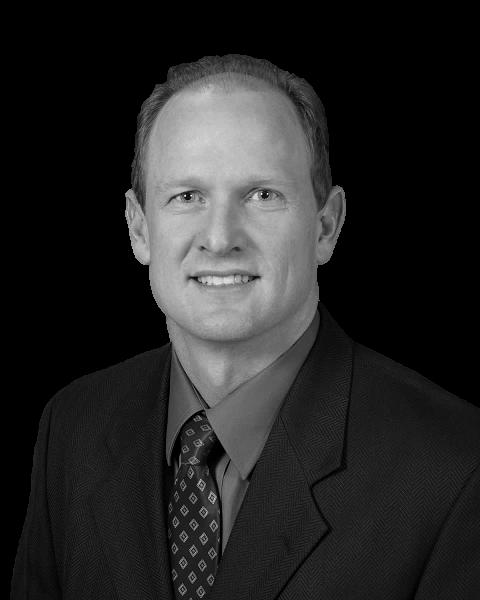
Page 20
These authors sometimes disagree, yet remain good buddies
Turning your Retail Center Into a Profit Center Without Breaking the Bank
Spring has finally arrived! Lots of you traveled to Tunica to see the latest in home innovations, and now that that you’ve been inspired, how do you use some of those ideas you saw at Tunica in your own homes and retail centers?

As a Lifestylist® much of what I do is designing new homes and staging the model homes to sell Your homes are your store - it’s where customers go to find their new dream home, so your homes need to get them excited about how much better their lives can be when they are living in one of your homes
One of the biggest dilemmas I see when I visit retail centers across the country is that after a home has been in a center for a few months, the sales people lose interest in it. They have been in it so many times it’s not new or fresh to them, and their lack of enthusiasm is transferred to prospective buyers
We teamed up with a retail center outside of Dallas, Texas - an amazing location that had gotten stale with management and as a result, the sales force. Sales had been slow, therefore there wasn’t a budget to spend the typical amount staging the model homes, and as a result, furniture and decor items had been moved from house to house, not really paying attention to if the furniture was the right scale and in good condition, or worked well together. Here’s what we were able to accomplish just by using things that were already at the center, and things you should look for when you walk your model homes
L i g h t
There are a lot of retail centers that don’t have power to all of their homes, and that was the case with these. Our photography isn’t up to what we usually like to do, but we made the best out of not having lighting.
Someone had added these very dark, dated drapes to this home that were also too short. We replaced the drapes using some ready-made ones from a local discount store and opened the blinds making the home feel full of light The furniture also didn’t help people understand how large the room was, so we swapped it with a sectional from another home We always use lamps, even when there isn’t power to add height and make the room feel complete.


Page 21
Photo by Lisa Stewart Photography
It’s not about just having furniture in a home, it’s about having the right furniture This home had a great floorplan, but the oversized counter height dining table made it feel small. We sold this table and chairs to a new home buyer, and took this glass top dining set that was pushed against a wall in a single section home that was too big there. We also changed out the rust colored living room furniture and found some neutral pieces that worked well with the dining set and the driftwood tones in the home We were barely able to get an after shot - the home sold immediately!




Page 22
e
Si z
M
t t e r s
a
Then we took the rust colored set from the home we just mentioned, moved the dining set away from the wall, and added some accessories and artwork from the storage room. It worked - the home sold right away, furniture and all!





Your value priced homes are the ones that you really need to spend some time on and make sure that they are decorated with the right sized furniture, and are full of personality. The dated furniture and lack of decor in this home wasn’t helping get the sales or attention that this home deserved We had a “model home furnishings sale” that brought lots of new traffic to the retail center and helped us get rid of some furniture and decor items that were dated, damaged, or the wrong scale.

Page 23 S i z z l e S i n g l
e s that
Let It Go
Using broken and dated items in your homes doesn’t save you money, it costs you sales.

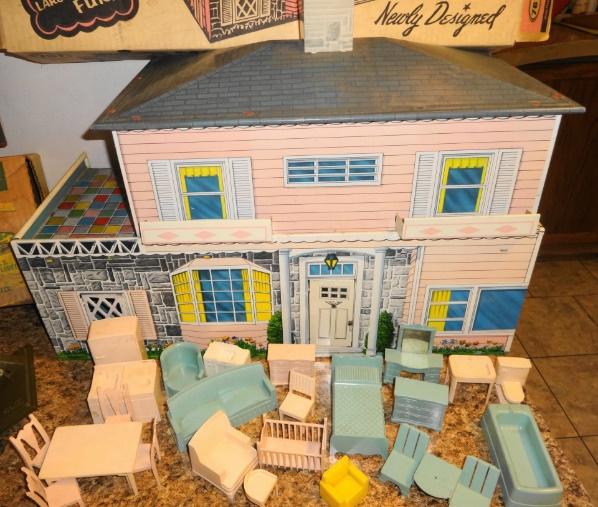
Model Home Furniture Sale
Have a sale that invites customers not only to buy your homes, but purchase furniture and accessories that you no longer need or work in your homes. It’s a great way to introduce new customers to your homes and to get some cash to invest back into your decors.
Be A Good Neighbor
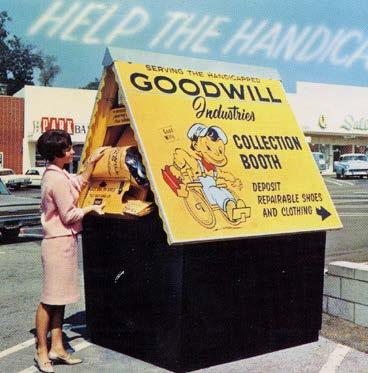
Identify a non-profit that you can work with to donate any items that you don’t sell, and alert media that you are helping the community. You can help some people who really need a hand and it also will provide lots of goodwill for your center.
Move Things Around
Don’t be afraid to move things into different homes. It will keep your models fresh and keep your sales team motivated. It can also be a great marketing tool - your sales team can reach out to buyers and invite them back to your sales center to see your new model homes.
Keep It Clean

Take a walk through your homes at least once a week and make sure that things haven’t been moved, broken, or stolen, and that your home is in move-in condition. No one wants to buy a dirty, cluttered home.

Page 24
Here are some of our favorite tips on increasing sales (and profits) at your sales center...
I am thrilled to have been asked to be a contributor to The Manufactured Housing Review, and I’m looking forward to sharing some of the things that make our industry so special. We will be at the MHI Congress and Expo in Las Vegas May 2-4, and at the National Communities Council Spring Forum on May 2nd. I’ll be speaking on this topic on Thursday, May 4th at the conference. I hope that you will say hello or come by and hear me speak - we are always available for questions and to help you with your homes and communities.
is one of those people who truly loves what she does. She has been active in the housing industry for over 30 years and is the only person to have been awarded National Best in Model Home and Clubhouse Merchandising awards by both the National Association of Home Builders and The Manufactured Housing Institute. Her work has been seen on the covers of numerous national home publications including Home Magazine and Modern Homes Magazine, and on HGTV. She realized that factory built housing was the housing of the future over 20 years ago, and has been actively working in and promoting the lifestyle that our homes offer ever since. She is a favorite speaker at the Manufactured Housing Institute Congress and Expo, and started American Housing Advocates as a way to share the great news about manufactured housing. Her work with manufactured housing model home interiors and land lease communities has received national attention, and retailers and manufacturers alike are embracing her lifestyle approach to our industry. Her online and social media presence at www.lifestylist.com and @lifestylist is read by thousands of loyal followers.

Page 25
Suzanne Felber
Suzanne S. Felber, Lifestylist® The Lifestylist Brands Lifestylist® Suzanne Felber




Page 26 GREAT RATES ~ GREAT SERVICE ~ GREAT VALUE Retailers Communities Developers Installers SPECIAL INSURANCE PROGRAMS Transporters Homeowners Tenants Investors
Ten Tips for Better Welfare States
The following is from James Bartholomew’s “The Welfare of Nations,” an interesting and educational book that compares, contrasts, and measures both the effectiveness and the consequences of various welfare systems from around the world.

1. Make housing cheaper by allowing supply to increase through an improved planning system. Public housing is a failed policy and is already being downgraded around the world.
2. Enable everyone to choose between competing private schools.
3. Create compulsory health savings accounts and health insurance provided by competing organizations. Allow patients to choose between competing doctors and hospitals.
4. Prefer social insurance to means-tested benefits. Allow private companies and mutual societies to offer it.
5. Make means-tested benefits a last resort, set at significantly lower levels than social insurance benefits. Both means-tested and social insurance benefits should be backed up by active demands that beneficiaries work, coupled with the provision of help in getting work.
6. Minimize benefits or accommodations given to single parents that are not also given to married parents.
7. Make financial support for care for the elderly as evenhanded as possible between those in institutions and those cared for by their children.
8. Replace unfunded government pensions with compulsory, individual, funded plans.
9. Introduce regular referenda for national, regional, and local issues.
10. Introduce constitutional limits on budget deficits and total debt.
The 20th century experienced an epochal war between capitalism and communism. Bartholomew argues that, out of the ashes of that conflict, the real winner has been neither communism nor capitalism it has been welfare statism– the new, defining form of government of our age that has swept across the advanced world.
Page 27
James Bartholomew is a journalist and an author with a wide range of international experience He is a fellow of the Institute of Economic Affairs and of the Adam Smith Institute. He is currently working on a new book about the welfare states of the world and how they are changing the way that people live and behave How have welfare states changed cultures and lifestyles? How is world civilization changing? He will be making comparisons between different welfare states and seeking out the models that perform the best and do the least damage. The working title of this new book is The Way We Live Now. His previous book, The Welfare State We’re In, about the British welfare state and its considerable damage to British society, won several awards including the Sir Anthony Fisher Memorial Award from the Atlas Foundation.

 James Bartholomew, Journalist, Author, Speaker
James Bartholomew, Journalist, Author, Speaker
Attending Vegas Trade Show
is a Good Investment
There are a lot of meetings in this business, and too many of them require expensive hotels and too many days away which I can’t afford. That, however, is far from the case when it comes to the Manufactured Housing Congress & Tradeshow in Las Vegas I’ve been going for more than a decade and it has always been worth my time. It is THE meeting place for the industry. Throughout the year, I’m frequently agreeing to meet colleagues in Vegas.
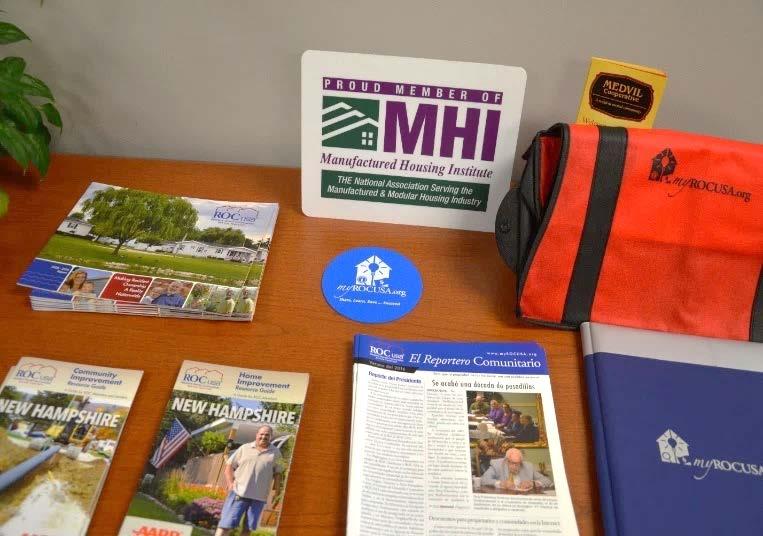
ROC USA® has had a booth since 2008 so that makes agreeing on a location to meet much easier (and alone worth the price) Beyond pre-arranged meetings, a booth generates many more connections that happen on the tradeshow floor I’ve met some great people and secured community purchase opportunities right then and there. If you want to meet more people in the business, getting a booth is worth the small investment as they are very reasonably priced ( Booths are very reasonably priced )

The workshops, I admit, run hot and cold. I prefer more audience interaction and better facilitation to get the most out of industry panels There are so many intelligent people in the business and I learn so much at National Communities Council day that happens during the first day of the tradeshow.
You can’t miss the great golf course, Legacy, that is a short taxi ride from the Strip
There’s a lot not to like about Vegas, really. The crowds that get in the way of getting from one place to another can be annoying Smoking is prevalent and stinky at times However, for this business, it’s worth the trip and the investment. Hope to see you in Vegas on May 2nd?
Paul Bradley, President ROC USA Resident Owned Communities
Paul Bradley is the founding president of ROC USA® , LLC. Prior to his appointment at ROC USA, he served as vice president for the New Hampshire Community Loan Fund. There he managed the Community Loan Fund’s 25-year old Manufactured Housing Park Program, expanding its cooperative development program, and initiating single-family lending and new production.

Page 29


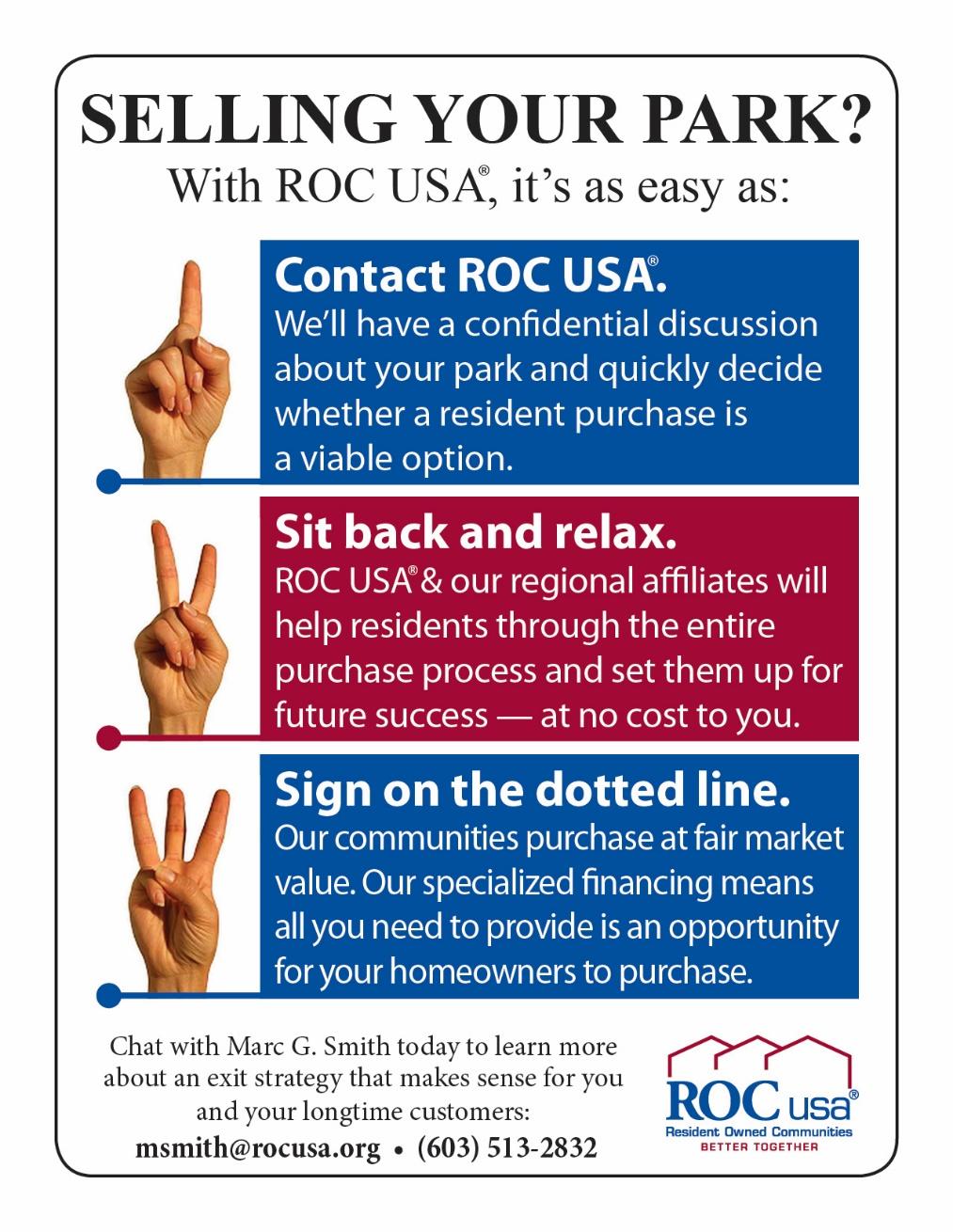
WHY
WE LOVE
INVESTING IN COLLEGE TOWNS
by Dave Reynolds
Many people get excited about college football. We get excited about college-town manufactured home communities. These properties display unique characteristics that provide greater stability and investment quality than virtually any other attribute. Warren Buffett owns only one commercial real estate property: a strip center across from NYU. He has said many times that the main reason he bought it was that college towns have superior real estate performance. So why do we love investing in college towns so much?
Recession-Resistant Economies
If you look at the unemployment rate and general economic condition of college towns following the 2007 Great Recession – when U.S. unemployment rose to around 10% -- you’ll find that most college towns had around half the national average How did they do so well? It’s because colleges are not really affected by economic cycles Most parents are going to send their kids to college regardless of whether or not the stock market is booming or collapsing And there are plenty of student loan programs in case parents are struggling Meanwhile, students are subsidized from home so it isn’t a necessity to spend money – they are insulated from the real world and so are those businesses that cater to them. In our opinion, there are three main employment drivers to a recessionresistant market: 1) education 2) healthcare and 3) government (federal, state, county and city). And if we could pick just one, it would be education, as colleges are catalysts for economic vitality
Create Employment by Association
Colleges provide well-trained labor for some specialty industries. Many high-tech companies are located in close proximity to major colleges with superior computer and engineering departments (such as Stanford and Google as well as Hewlett Packard) Similarly, many healthcare concerns are located next to colleges to take advantage of trained medical students (such as Barnes Hospital and Washington University in St. Louis). Equally important is that many of these industries are high-growth and represent cutting edge technology, which has the power to potentially shape an entire region (such as Silicon Valley). College towns are basically strong job creators that are extremely prolific
Stable Housing Markets
College towns are strong economic engines; therefore, housing prices are extremely stable and typically high. Elevated median home prices and apartment rents create a strong need for affordable housing, making the mobile home park one of the few solutions Additionally, college towns are typically upscale, which creates a living environment that offers superior public schools and other attributes that make people want to live in the area, even if they work elsewhere in the metro. University Park, Texas – where Southern Methodist University is located – has a median home price of $1,427,000. For those who think that’s the most extreme example in the U.S., you will find that the median home price in Palo Alto, California (where Stanford is located) is $2,562,600.
Page 33
GI Bill Legacy
At the end of World War II, the U S government offered returning soldiers the “G I Bill” which essentially provided college at low or no cost. As a result, the government relocated the roughly 500,000 mobile homes they had purchased during the war (and used for base housing) to college campuses nationwide. Mobile home parks became common fixtures that, over time, transitioned from G I Bill to simple affordable housing Virtually every college town in the U S has a selection of mobile home parks, many of which have all the right features as far as city utilities, paved roads, large lots and strong locations are concerned.
Examples
We are the largest owner of mobile home communities in Champaign-Urbana, Illinois We have a large investment there because Urbana is the home of the University of Illinois, one of the largest public universities in the U.S., with over 44,000 students. The metro area has a population of 238,984, a median home price of $129,000 and an average three-bedroom apartment rent of $1,038 per month And that’s why these properties do extremely well We also have large holdings in Austin, which is the home of the massive University of Texas, with over 50,000 students and 24,000 faculty and staff The Austin metro is 931,830, with a median home price of $299,400 and an average three-bedroom apartment rent of $1,610 per month. Again, this is the perfect market for mobile home parks. But even in markets with smaller colleges, these same fundamentals will often be found.

Conclusion
College towns are great locations for mobile home parks. When you see properties located in these areas, you should definitely stop and take a further look. While college football is fun to watch, college-town mobile home park checks are fun to deposit. That’s why we love college towns!
Dave Reynolds has been a manufactured home community owner for almost two decades, and currently ranks as part of the 5th largest community owner in the United States, with more than 23,000 lots in 28 states in the Great Plains and Midwest. His books and courses on community acquisitions and management are the top-selling ones in the industry. He is also the founder of the largest listing site for manufactured home communities, MobileHomeParkStore.com. To learn more about Dave’s views on the manufactured home community industry visit MobileHomeUniversity.com

Page 34
DAVE REYNOLDS Co-Founder



Page 35 Play
Investing in Troubling Times
by Austin Lewis
When it comes to investing, emotions can really get in the way Today, we have a perfect storm for the emotional investor President Trump, his administration, Congress, the courts, and the media have created news cycles that rapidly change every 24 hours. It is breathtaking and exhausting. Some investors are fearful, others are overconfident
All investors want to know what is going to happen Some feel the market is dangerously overvalued and others feel the run will continue. Some investors are trying to time the markets. Some want out, others want in Who is right?
In order to successfully time the markets, you must make two correct decisions at precisely the right time: 1) when to get out, and 2) when to get back in. But, most investors do exactly the wrong thing at the wrong time When the markets have been hot and there is no trouble in sight (a sell signal), investors pile in more money “to make hay while the sun shines.” When markets have crashed and there are problems everywhere (a buy signal), most investors run away because “it is too risky to invest in the market right now ”
While the allure of market timing never goes away, it cannot be done consistently over time. There is another way
Instead of Trying to Time the Markets, Use an Asset Allocation Instead
Asset allocation involves investing your portfolio among several different asset classes and maintaining a consistent exposure to these asset classes over a long period of time. Using an asset allocation has several advantages.
First...using an asset allocation can reduce the overall volatility of your portfolio because each asset class performs differently - some are up when others are down While a properly designed asset allocation will not prevent you from experiencing loss, it can help you limit your downside and smooth out your performance over the long run.
Second...an asset allocation can improve portfolio diversification Most portfolios contain stocks and bonds, and this is a good place to start Bonds help provide some measure of down side protection. Stocks provide upside and long-term growth potential. In many cases, you can improve the risk/return profile of a stock and bond portfolio by adding other asset classes, like real estate, commodities, and hedging strategies
Third...using an asset allocation makes managing your investments much easier and less stressful It also provides vital investment discipline through the rebalancing process When markets are on the move, you don’t have to be a fortune teller and know where they are going; you just need to rebalance back to your target allocation. For example, if stocks take a tumble and bonds have increased in value, you will rebalance by buying stocks and selling bonds In this way, you are automatically buying into an asset class when it’s undervalued (buying stocks low) and selling an asset class when it’s overvalued (selling bonds high) – not the other way around
During stressful periods, having a stable asset allocation can help shelter you and provide important discipline to successfully navigate all the emotional traps we can fall into as investors from time-to-time.
Page 36
Be a Long-Term Investor, not a Short-Term Speculator

Investing creates real wealth. This wealth is created when natural resources, skilled labor, intellectual capital, and financial capital is skillfully combined in an enterprise to generate profits. As investors we want to capture some of that wealth and make it our own We do this by providing the financial capital part of the equation We can provide this capital in exchange for an equity interest (stocks) or as a creditor (bonds). When we hold stocks, we expect them to appreciate in value and, in some cases, receive dividend income When we hold bonds, we expect periodic interest payments and eventually the return of our original capital This is how capitalism works, and it has been working very well for a long period of time. The bulk of personal financial wealth in the world has been crated through this time-tested

process
Speculating is not investing. It involves making a bet against someone else that the value of something is going up or down, usually on a short-term basis Because there are two sides to every bet, there is a winner and a loser It’s a zero sum game At the end of the day, no real net wealth is created, other than those who receive a fee for making the market where the participants place their bets
Of course, there is value to speculation because it can make our markets more efficient, but as we have learned recently, this is not always so To win as a speculator, you must be right many more times than you are wrong over a long period of time. This can be a very daunting and expensive task. Not all speculation is bad, and not all investing is good. That being said, we have a much better chance of financial success when we act as long-term investors the great majority of time.
Diversification means not having so much of one thing that we make a killing, but also not being killed by any one thing A properly designed investment portfolio must be properly diversified Diversification is the best strategy to avoid taking catastrophic losses in your portfolio. Most investors understand the importance of diversification, but it is often overlooked, especially when the investor falls in love with one manager, mutual fund, stock, strategy, etc.
Page 37
Austin Lewis is a wealth manager at Lewis Wealth Management, a firm he founded in 2010. He focuses on providing wealth management solutions to a select number of affluent clients in a boutique setting. He is a

CERTIFIED FINANCIAL PLANNER professional

Austin has over 25 years of experience in advising clients as a banker, attorney, and financial advisor. Austin started his career as a business banking officer with Wells Fargo Bank. Upon graduation from law school, Austin practiced law for nine years at two prestigious San Francisco law firms: Gordon & Rees and Craigie, McCarthy & Clow, where he specialized in advising businesses on litigation and transactional matters. When Austin returned home to Colorado in 2001, he served as senior in-house counsel to two Colorado companies: Graphic Packaging and Qwest Since 2005, he has been advising affluent clients on all their financial matters.
Austin received a B.S. in Business Administration from the University of Colorado in 1986, an M.B.A. from San Francisco State University in 1989, and a law degree from Marquette University in 1992.
Page 38
Lewis Wealth Management is a fee-only, investment advisory firm based in Greenwood Village, Colorado. www.LewisWM.com.
Louisiana Manufactured Housing Association, LMHA
Crawfish Boil
http://lmha.com/2017/02/09/april-19th-lmhacrawfish-boil-4-8pm/
April 19, 2017 = Baton Rouge, LA
Manufactured Housing Institute, MHI National Congress & Expo
http://www.congressandexpo.com/
May 2-4, 2017 = Las Vegas, NV
Illinois Manufactured Housing Association, IMHA Annual Conference
https://imha45.wildapricot.org/event-2407058
May 17, 2017 = Chicago, IL
Mobile Home University, MHU Park Investing Boot Camp
http://www.mobilehomeuniversity.com/mobilehome-park-investing-books-and-courses/mobilehome-park-investors-boot-camp.php
May 19-21, 2017 = Denver, CO
Texas Manufactured Housing Association, TMHA Fishing Outing
http://www.texasmha.com/events
May 23, 2017 = Aransas Pass, TX
Manufactured Housing Association of Oklahoma, MHAO
Annual Convention
http://www.mhao.org/
June 20-21, 2017 = Durant, OK
Manufactured Housing Communities of Arizona, AZMHCA
Annual Conference
http://azmhca.com/
June 21-23, 2017 = Chandler, AZ
Texas Manufactured Housing Association, TMHA Annual Convention
http://www.texasmha.com/events
September 10-12, 2017 = Dallas, TX
Manufactured Housing Institute, MHI Annual Meeting
http://www.manufacturedhousing.org/mhiannual-meeting/
September 17-19, 2017 = Orlando, FL
Southeast Community Owners, SECO Annual Symposium
http://www.secoconference.com/
October 11-12, 2017 = Marietta, GA
Western Manufactured Housing Communities Association, WMA Convention & Expo
http://www.wma.org/event/2017-wmaconvention-expo
October 16-19, 2017 = Reno, NV
National Communities Council, NCC Fall Leadership Forum
http://www.manufacturedhousing.org/ncc-fallleadership-forum/
November 1-3, 2017 = Chicago, IL

Page 39


Page 40 ManufacturedHousingReview.com Communications regarding any alleged offending, inappropriate, inaccurate or infringing content should be directed immediately to kkelley@manufacturedhousingreview.com along with the communicator's contact information. 281.460.8384 We are an electronically delivered monthly magazine focused on the Manufactured Housing Industry. From Manufactured Home Community Managers, to Retailers, to Manufacturers, and all those that supply and service them, we supply news and educational articles that help them run their businesses. MANUFACTURED HOUSING REVIEW, LLC Have something to contribute or advertise? = staff@manufacturedhousingreview.com
 by Valerie Jurik
by Suzanne Felber
Frank Rolfe
by Kurt Kelley
by Paul Bradley
by Austin Lewis
by Spencer Roane
by John Graham
by Kurt Kelley and D.J. Pendleton
by James Bartholomew
by Dave Reynolds
by Valerie Jurik
by Suzanne Felber
Frank Rolfe
by Kurt Kelley
by Paul Bradley
by Austin Lewis
by Spencer Roane
by John Graham
by Kurt Kelley and D.J. Pendleton
by James Bartholomew
by Dave Reynolds









 David Roden is President and CEO of MVE, Inc.
David Roden is President and CEO of MVE, Inc.











































 James Bartholomew, Journalist, Author, Speaker
James Bartholomew, Journalist, Author, Speaker

















